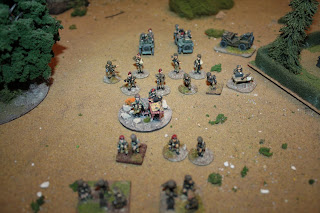The two forces were Skaven and Undead from my extensive Oldhammer collection.
A few things I might consider changing for future games:
- In our hexified rules, it is stipulated that a full hex should be maintaind between units. This is the equivalent of the 3" proximity rules between units in the original Rampant rules. For the medieval games, this worked quite well, since 6 or 12 25mm models overflow the hex significantly, and hence, providing a buffer zone between units (a single hex), helped the game.
However, since Dragon Rampant works with Strength Points per unit (and which are not necessarily equal to the number of figures), this problem is less pronounced. Hence, units can be made to fit a hex rather nicely, and there is no need to keep a visual buffer between units. So perhaps the 1 hex distance between units can be lifted, and a tighter density of units on the table is possible. This in turn would make it easier to play bigger battles. - Talking about bigger battles, as a player you naturally want more coherent behavious between units. I.e. you want units to move together rather than all individually. So I think we need to introduce some type of group order. E.g. all adjacent units can be given the same order (move, attack, ...), but using the least favourable activation role of any unit in the goup. A further penalty might be introduced (a -1 or even -2?) to balance the fact that it otherwise would be too easy to move a large number of units in a single turn.






























